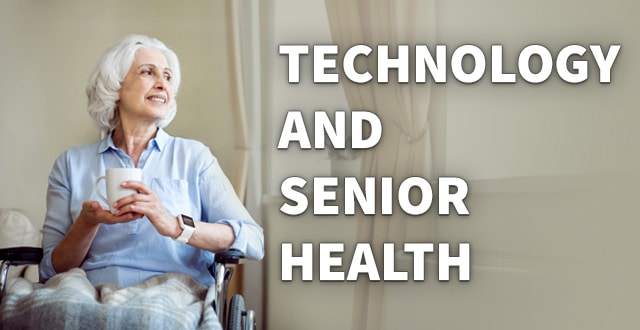Baby Boomers continue to live long and healthy lives well into their 80’s. For society, it has enormous implications on how to care for an aging population in a way that keeps them independent. According to the Census Facts For Features, 44.7 million senior citizens 65 and older existed on July 1st, 2013. By 2060 the projected population of people 65 and older lists as 98.2 million. Of that number, 19.7 million would be 85 years old or more. Business sees this as an opportunity to perform social responsibility for communities and make money. Presently, many businesses in that sector have been discussing how to offer services that allow seniors to “age-in-place.”
Trends
Advances in telecommunications and cloud computing have made it possible to create sensory networks with advanced bio-sensing devices. The technology has been used by athletes to improve performance for years now. Government agencies have been campaigning for alternatives to assisted living or nursing homes. The expense of such facilities often leaves the elderly destitute or the families financially strapped. According to medicare.gov’s official site, Medicare and Medicaid are on board to find solutions beyond the traditional means.
Mather’s LifeWays Institute on Aging did a survey with 600 senior living organizations from 15 states with 1000 communities participating. The trends currently look like social connection programs in communities have been a key transition point for senior citizens. Grouping together in an area makes it easy for a community to offer services tailored to that population’s needs. Home-bound and in-home care services continue to grow rather than nursing homes. Advanced smart home technology creates safe environments with a touch or a swipe and allow a higher level of independence for the elderly. Seniors with money tend to update to smart homes in urban areas.
Wearables
Most people are familiar with safety monitoring and accompanying assistance technologies that notify if a senior has fallen or needs attention. Enabling technologies have continued to develop that were originally for sports, such as devices that check heart rate and blood pressure, as it does for athletes. These items have now moved into clothing or accessories known as “ wearables.”
Unaliwear, an Austin-based company, makes a watch that detects rapid acceleration that may indicate an impending fall. It functions as a wearable OnStar. CarePredict has a wrist bracelet that detects behavior with location and motion sensors. The software analyzes what the behavior is and transmits the data to the company. Smartstones makes a stone that detects light, sound, and vibration. A touch can transmit if the person needs help or where they have arrived. If walking has become a problem, then a device by WalkJoy exists when wrapped around the knees its sensors determine velocity and angle of the foot. Then in an electrical chain reaction, it sends a pulse to the heel as it hits the ground which awakens the motor system to function and the wearer walks. Plenty of room exists for investment, innovation, and pilot programs by organizations that work with the elderly. This niche has developed to the point a Wearable Conference developed which has several global conferences a year highlighting the many gadgets created just for quality of senior living.
Implementation
The technology has proven viable and useful for those senior citizens discovering it. The system of senior care has developed into a complex system. Navigating Medicare, Medicaid, regular health insurance, assisted living, nursing homes, and in home health care with all its many statues and laws makes it difficult to change. Not enough money in the world exists within most families to adequately take care of elderly family members in a way that lets them continue independence except by technology or grand genetics. Depending on the state, senior care is estimated $2000 to $8000 a month for the regular means of taking care of an ageing parent, which most families do not have. Applying wearable and similar technologies do alleviate other costs as proven by Great Britain’s tracking in its national health care system with the use of the Telehealth monitor that reduced emergency room visits by 20 percent which in turn reduced costs. The FCC reported that body sensors had reduced costs in hospitals for in-house infections by $12,000 per patient. It saves money on many levels.
The heart of the matter is that most medical facilities have workflows and fitting in a personalized third party outside the normal medical personnel takes some thinking and compromise. It will take adjustments to the health care system to place these technologies with the normal pharmaceutical and traditional techniques. Ageing in place has become an option many senior citizens want, but it is a niche market presently. What is missing is the infrastructure to make it available to the masses, to the poor, and the indigent. The website, Ageing in Place (www.ageinplacetech.com/), gives a daily review of policy changes, studies, and new technology by news items and report. The organizational aspect of creating a network of elderly care technologies across this nation, organized in a way that lets healthcare professionals access it easily, has yet to happen. For it to reach major cost savings to relieve a burgeoning Medicare/Medicaid system, it will take another national system of health technology to create the alternative.
Basic Goal
The Constitution states it best. The function of government is to provide for the general welfare of the general public. Using Alexander Hamilton’s interpretation, health technology comes under that directive. It will take law to lay the foundation of “ageing in place” using technology. It will also take the support and voices of senior citizens, the disabled, handicapped, military veterans, and families to take the personal health technologies to the next level. Hopefully, with these long lives, this technology support will give elderly the pursuit of happiness with blessings of liberty as long as possible.
VIA:
https://www.ageinplacetech.com/
https://www.payingforseniorcare.com/longtermcare/costs.html
http://www.census.gov/newsroom/facts-for-features/2015/cb15-ff09.html
https://www.medicare.gov/nursinghomecompare/Resources/Nursing-Home-Alternatives.html
http://www.aplaceformom.com/blog/1-3-14-innovative-senior-technology-startups/
http://www.homecaremag.com/top-10-technology-devices-seniors
http://seniornet.org/blog/10-pieces-of-technology-seniors-should-embrace/
http://www.agingwisely.com/the-role-for-technology-in-eldercare-and-senior-healthcare/
http://www.gerontechnology.info/index.php/journal/article/viewFile/gt.2014.13.02.279.00/2182

